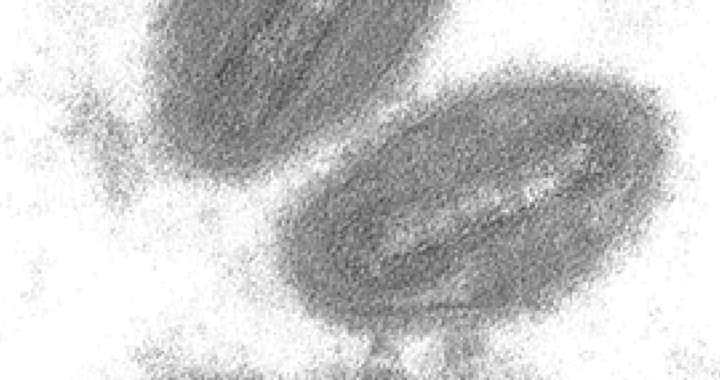The monkeypox virus or MPOXV is a double-stranded DNA virus that belongs to the Orthopoxvirus genus in the Poxviridae family. It is a disease-causing and infectious pathogen similar to cowpox and the now-eradicated smallpox virus that affects several animals including rodents and primates, and it is also responsible for the human monkeypox disease or mpox.
Danish virologist Preben von Magnus first discovered the virus in 1958 in crab-eating macaque or long-tailed macaque monkeys used in animal experiments. The first known outbreak in the human population occurred in the 1970s in the Democratic Republic of Congo. The virus has been considered endemic in Central and Western African countries.
The exact origin of the virus or when the disease first appeared remains unknown. What is clear is that it is prevalent in wild animal species endemic in the rainforest regions of Central and Western Africa. Experts are also uncertain as regards the circumstances behind the first spillover event that resulted in the virus jumping from wild animals to humans.
Outbreaks of human monkeypox disease occur frequently in Africa. The first outbreak outside the African continent transpired in 2003 in the United States. In addition, the most recent outbreak occurred in 2022 in the United Kingdom and other European countries. Australia, Canada, and the U.S. also have reported cases of human monkeypox disease.
Understanding the Transmission of Monkeypox Virus: Mpox is Transmitter
Considering how it is endemic in wild animal species and the reported instances of outbreaks through the years, how exactly is the monkeypox virus transmitted? What are the factors that contribute to its transmission? How efficient it is in spreading across the human population?
Animal-To-Human Transmission
It is important to note that the monkeypox virus is a zoonotic pathogen. Zoonoses are infectious agents such as viruses, bacteria, prions, and parasites that have jumped from animals to humans. Examples of these agents include the Ebola virus that causes the Ebola disease, the earlier strains of the human immune deficiency virus or HIV, different strains of influenza, and coronaviruses such as the SARS-COV-2 that causes the COVID-19 and COVID-19 pandemic.
There are two types of zoonosis: direct zoonosis and indirect zoonosis. In direct zoonosis, the infectious agent is transmitted directly from animals to humans either through direct contact or through mediums such as air and water. Indirect zoonosis involves transmission occurring through intermediary species or vectors that serve as carriers without getting infected.
Several instances of monkeypox disease outbreaks in the human population suggest that the monkeypox virus is transmitted through direct zoonosis, particularly when humans come in contact with infected wild animals or vector animals. The 2003 outbreak in the U.S. was traced to imported wild animals from Africa that infected prairie dogs which then infected humans. Note that prairie dogs are susceptible to severe monkeypox disease.
Note that animal-to-human transmission of the monkeypox virus can occur through either an animal bite or direct exposure to the blood or other bodily fluids of an infected animal. Susceptibility to infection is higher when these fluids come in contact with broken skin or mucous membranes. In addition, humans can also get infected if they consume or touch the meat or other body parts of an infected animal such as its skin and fur.
Human-To-Human Transmission
Experts believe that human-to-human transmission is rare but possible. The monkeypox virus spreads primarily through large respiratory droplets. However, upon entering and reproducing inside a human body, its transmissibility is not efficient. Furthermore, respiratory droplets are large and they cannot travel more than several feet away. Prolonged face-to-face contact is required for human-to-human transmission to transpire.
Other human-to-human transmission routes of the monkeypox virus include close contact with skin lesions or exposure and contact with the bodily fluids of an infected person. Mother-to-child transmission transpires via the placenta or through close contact during and after giving birth. The World Health Organization explains that transmission through different forms of sexual intercourse remains unclear and understudied.
The virus can also spread indirectly if an uninfected individual comes into contact with contaminated inanimate objects or fomites. Epidemiologists have noticed that the longest chain of monkeypox transmission in a particular community has lengthened in recent years from six to nine successive person-to-person infections. Some have hypothesized that this may be due to the weakening herd immunity due to the cessation of smallpox vaccination.
Furthermore, the recent outbreaks that started in the U.K. around April of 2022 have also left experts baffled. Most of the cases in Europe involved individuals with no person-to-person interaction nor connection to the previously confirmed cases. Public health authorities are still investigating how exactly the human monkeypox disease spread in different countries. Some have suspected that the virus might have been spreading undetected.
FURTHER READINGS AND REFERENCES
- Kozlov, M. 2022. “Monkeypox Goes Global: Why Scientists Are On Alert.” Nature. DOI: 1038/d41586-022-01421-8
- Sklenovská, N. and Van Ranst, M. 2018. “Emergence of Monkeypox as the Most Important Orthopoxvirus Infection in Humans.” Frontiers in Public Health. 9. DOI: 3389/fpubh.2018.00241
- The World Health Organization. “Monkeypox.” Fact Sheets. The World Health Organization. Available online
